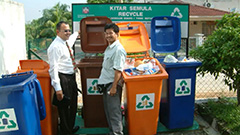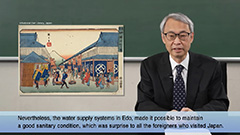Using the materials in JICA Knowledge Co-Creation Programs (KCCP) for more than 10 years
JICA Kansai has been using many JICA-Net multimedia-based learning materials in the field of waste management and water resources in KCCP, “Municipal Solid Waste Management Practice(A), (B)”, and “Operation and Maintenance of Urban Water Supply System (Water Quality and Purification) (A)”
Regarding the Waste Management course, including the previous program, we have been using the materials for over 10 years. Although the actual number of people is unclear, it is estimated that there will be more than 100 participants to whom we recommend watching the materials.
I learned about JICA-Net multimedia-based learning materials in a seminar held by JICA-Net Library. Until then, we used existing materials released by public institutions or private companies.
However, we felt that it was difficult to adopt these materials as official materials for KCCP course because of the limited visuals, few new ones, no English versions and high copyright hurdles.
Regarding that point, we felt that JICA-Net multimedia-based learning materials were of relatively high quality, with a strong message and well-summarized content. For that reason, we adopted them.
Introducing some materials that we use

In Malaysia, the data management system was built and 3R activities and environmental education were implemented.
We introduce some materials that we use in the field of waste management and water resources in KCCP.
“Case Studies of applying Japan’s waste management Experiences and Technologies in Developing Countries” (YouTube, external link) shows overseas examples of introducing Japan’s experience and technologies in the field of waste management in Sudan, Palestine, El Salvador, Bangladesh, Malaysia, and Vietnam.
This material was created in 2023 with “Overview of Japan's Experience in Waste Management” and “Practices of Municipalities on Waste Management in Japan” as a series that aims to utilize Japan’s experience in waste management to help solve current issues in developing countries.
In the “How has Japan Achieved Universal Access to Safe Drinking Water? — Japan’s Infrastructure Development: the Case in Urban Water Supply Systems” (YouTube, external link), JICA invites TAKIZAWA Satoshi, Director of the Research Center for Water Environment Technology, and Professor of the Department of Urban Engineering, Graduate School of Engineering, the University of Tokyo. In the first half, he looks back at the history of how it was possible to achieve a safe and wide-range water supply, and, in the second half, in a lecture format, explains how the capabilities of Japanese engineers were developed successfully, especially during the process of modernization.
There are other materials such as “Slow sand filtration: creating clean, safe water” (YouTube, external link), “Reducing Waste Through the Promotion of Organic Waste Composting” (YouTube, external link), “Takakura Composting Method” (YouTube, external link), and “Road to Sanitary Landfill- The Fukuoka Method (Semi-Aerobic Landfill)”, which have been used for a long time as standard materials.

The material explains Japan’s experience and knowledge of water supply systems in a lecture format.
The materials complimented what was not covered at the lecture
Before COVID-19 pandemic, we distributed to participants the DVD materials during the face-to-face course. At present, we provide them with the YouTube link of the materials or explain how to view it on JICA-VAN for remote or hybrid courses.
Because participants’ specialties and experiences are diverse, we use the materials as self-study to complement group lectures and visits based on their respective needs and we also make use of these during the question session or as supplementary explanation to promote understanding by screening parts of the video.
There are some advantages to using the materials. These are easy to understand with images and videos. Because the materials are created based on JICA’s comprehension and cooperation policy of the said field, there is no need for a supplemental explanation that is usually required when using existing materials created by external specialists, making the training efficient.
Moreover, participants can always watch the materials according to their condition and environment, especially, can use the open materials to promote after returning to their own countries. Thus, the materials can be used in various situations.
Considering these advantages, we think we can introduce the materials to long-term participants and their supervisors through JICA-Chair.
Since the materials can be used flexibly for different people and situations, we would like to use them widely in the future.
The staffs in charge of environment field courses.
Training Program Division,
JICA Kansai
*The Material(s) mainly applied
Case Studies of applying Japan’s waste management Experiences and Technologies in Developing Countries
This educational material introduces projects incorporating fixed-time fixed-place waste collection system in the Sudan, inter-municipal waste management in Palestine, introduction and maintenance of sanitary landfill site in El Salvador, establishment of community participatory waste management system in Bangladesh, building the data management system and implementing 3R activities and environmental education in Malaysia, and promotion of 3R activities with the involvement of many stakeholders in Vietnam.
JICA is working toward ""improvement of waste management and promotion of a sound material-cycle society"" under the JICA Clean City Initiative.
This video was created with the aim of supporting to tackle current issues in developing countries through Japan's experience in waste management as a video resource for the educational material ""Japan's Experience on Waste Management"".
We hope that it will be utilized by those involved in waste management, including administrative personnel in developing countries, students majoring in the field of environmental management, and those involved in international cooperation.
How has Japan Achieved Universal Access to Safe Drinking Water? — Japan’s Infrastructure Development: The Case in Urban Water Supply Systems
In this video, we will present Japanese development experience in the water supply sector.
This lecture answers two questions.
The first question is, why was it possible to extend the water supply coverage to 98% of the total population in Japan, and why was it possible to supply safe drinking water 24 hours a day, every day?
The second question is, what are the reasons that the capabilities of Japanese engineers developed successfully through learning foreign technologies during the process of modernization?
This video series provides a comprehensive summary, by development issue, according to the lineup of JICA’s cooperation strategy called the “JICA Global Agenda.”
These video lecture shall be widely disseminated to JICA chair participants, participants, JICA staff, and other interested parties. To have them learn about the process by which Japan has solved development issues.




scroll